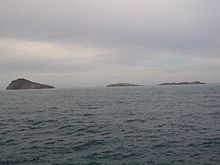Islas Chafarinas
| Disputed islands | |
|---|---|

Chafarinas Islands viewed from Morocco
|
|
| Geography | |
 |
|
| Location | Mediterranean sea |
| Total islands | 3 |
| Major islands | Isla del Congreso Isla Isabel II Isla del Rey |
| Area | 52.5ha |
| Administered by | |
| Spain | |
| Claimed by | |
| Morocco | |
The Chafarinas Islands (Spanish: Islas Chafarinas IPA: [ˈizlas tʃafaˈɾinas], Berber: Igumamen Iceffaren or Takfarinas, Arabic: جزر الشفارين or الجزر الجعفرية), also spelled Zafarin, Djaferin or Zafarani, are a group of three small islets located in the Alboran Sea off the coast of Morocco with an aggregate area of 0.525 square kilometres (0.203 sq mi), 45 km (28.0 mi) to the east of Nador and 3.3 km (2.1 mi) off the Moroccan town of Ras Kebdana.
The Chafarinas Islands are one of the Spanish territories on North Africa off the Moroccan coast known as plazas de soberanía.
These offshore islands were uninhabited and unclaimed at the time the French government decided in 1848 to occupy them in order to monitor the unruly tribes living in the border area between Morocco and French Algeria. A small expedition under the command of Colonel MacMahon (the future Marshal MacMahon) left Oran by sea and by land in January 1848 to take possession of the islands. Forewarned by its consul in Oran, Spain, which also coveted the Chafarinas, quickly dispatched a warship to the islands from Malaga. When the French arrived, the Spaniards had already taken possession of the islands in the name of Queen Isabel II.
The Chafarinas Islands are made up of three islands (from west to east, with areas in hectares):
Under Spanish control since 1847, there is a 190-man military garrison on Isla Isabel II, the only stable population on the small archipelago, down from 426 people in 1900 and 736 people in 1910.
The islands had a certain relevance in Spanish environmentalist circles during the 1980s and 1990s as the very last individual of Mediterranean monk seal in Spanish territory lived there, until it disappeared in the 1990s. Nine out of eleven marine invertebrates considered endangered species and the second largest colony in the world of the endangered Audouin's gull inhabit the islands.
...
Wikipedia
